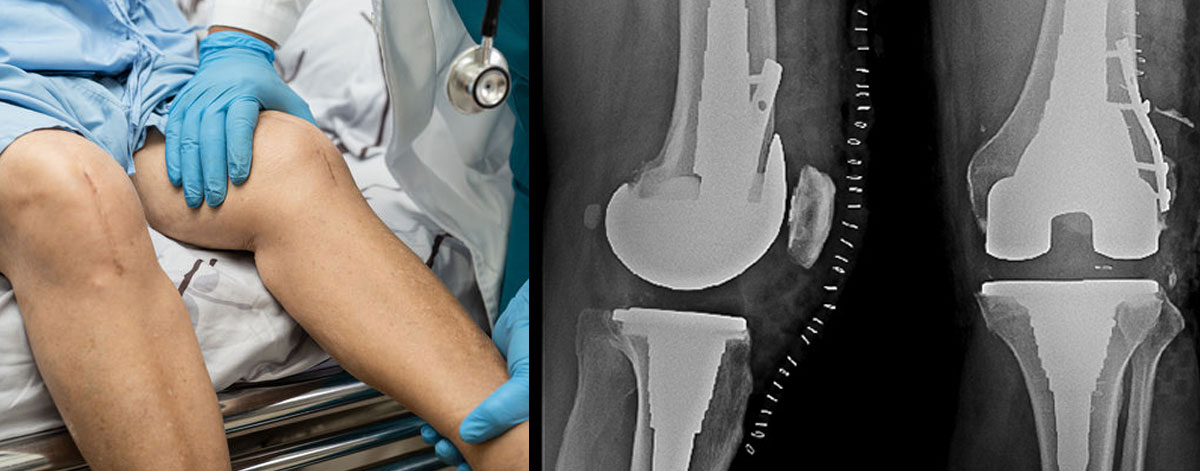Revision Knee Replacement
A revision knee replacement, also known as revision total knee arthroplasty (TKA), is a surgical procedure performed to replace a previously implanted artificial knee joint with a new prosthesis. This procedure becomes necessary when a primary knee replacement has failed or has worn out over time. There are several reasons why a primary knee replacement may require revision, such as:
- Loosening: The bond between the bone and the original implant may weaken over time, leading to instability and pain.
- Infection: In some cases, infection may develop around the knee joint, leading to the need for revision surgery to remove the infected components and implant new ones.
- Wear and Tear: The artificial joint may wear out over time due to normal wear and tear, especially in younger patients or those with more active lifestyles.
- Fractures: A fracture around the knee implant can compromise the stability of the joint and necessitate revision surgery.
- Instability: Some patients may experience recurrent dislocation or instability of the knee after a primary replacement, requiring further intervention.
- Implant Breakage or Malposition: Rarely, the original knee implant may break or be incorrectly positioned, necessitating revision surgery to correct the issue.
The revision knee replacement procedure is similar to the primary knee replacement, but it tends to be more complex and challenging due to the presence of the existing implants and potential bone loss from the initial surgery. The procedure typically involves the following steps:
- Preparation: The patient undergoes a thorough evaluation, including medical history, physical examination, and imaging tests, to assess the condition of the current knee replacement and plan for the revision.
- Anesthesia: The patient is given general or regional anesthesia for the surgery.
- Incision and exposure: The surgeon makes an incision over the knee to access the existing knee joint and remove the old implants.
- Removal of old implants: The surgeon carefully removes the old prosthetic components, taking care not to damage the surrounding bone or soft tissue.
- Correction of bone defects: In cases where bone loss has occurred around the knee joint, the surgeon may use bone grafts or specialized metal augments to reconstruct and restore the bone structure.
- Implant placement: Once the bone is prepared, the new knee implants are inserted into the joint. These may include revision-specific components designed to address the challenges posed by the previous surgery.
- Knee alignment and stability: The surgeon ensures proper alignment and stability of the knee joint with the new implants.
Do's for Revision Knee Replacement
- Follow Pre-operative Instructions: Adhere to your surgeon's pre-operative guidelines, which may include fasting instructions and medication restrictions.
- Prepare Your Home: Make sure your home is safe and accessible for your recovery, with clear pathways and assistive devices like a walker or crutches if needed.
- Attend Physical Therapy: Participate in physical therapy before and after surgery to strengthen your knee and improve its range of motion.
- Comply with Medications: Take prescribed medications as directed, including pain relievers and antibiotics, to manage pain and prevent infections.
- Keep the Incision Clean: Follow your surgeon's instructions on caring for the surgical incision to prevent infections and promote proper healing.
- Control Swelling and Pain: Use ice packs and elevation to control swelling, and take pain medications as prescribed to manage discomfort.
- Follow Weight-bearing Guidelines: Follow your surgeon's instructions regarding weight-bearing limitations after surgery to protect the newly revised knee.
Don'ts for Revision Knee Replacement
- Overexert Yourself: Avoid overexerting the revised knee during the early stages of recovery. Follow your physical therapist's guidelines and gradually increase activity as advised.
- Neglect Physical Therapy: Continue with your physical therapy sessions diligently to regain strength, flexibility, and function in your knee.
- Ignore Signs of Infection: If you experience signs of infection, such as fever, increased redness, swelling, or drainage from the incision, contact your surgeon immediately.
- Neglect Wound Care: Properly care for the surgical incision as instructed by your surgeon to prevent infection and complications.
- Engage in High-Impact Activities: Avoid high-impact exercises or activities that may put excessive stress on the revised knee.
- Sit for Prolonged Periods: Avoid sitting or lying in one position for too long to prevent stiffness and discomfort.
- Smoke or Use Tobacco Products: Smoking can negatively affect the healing process, so it's best to avoid tobacco during your recovery.

